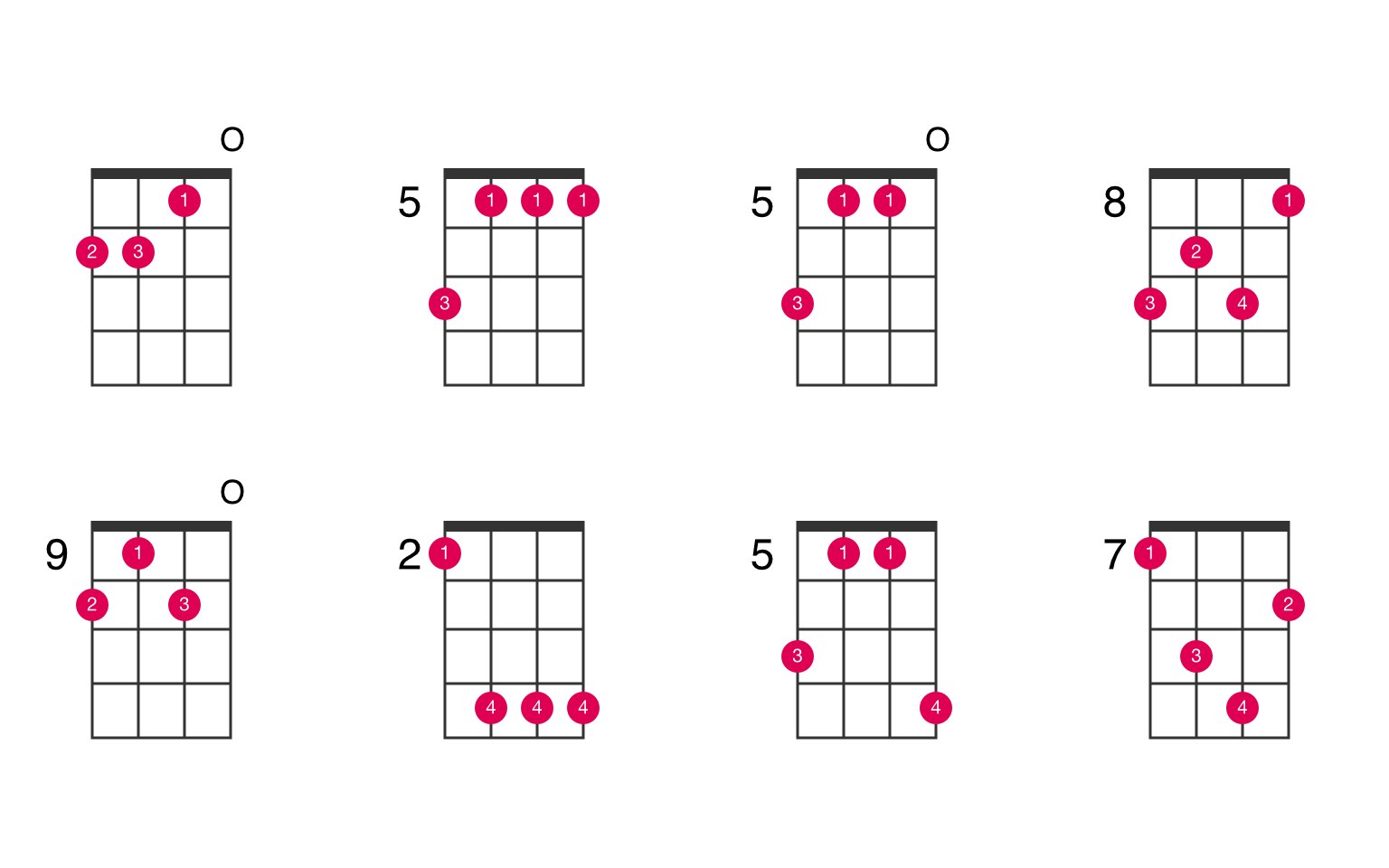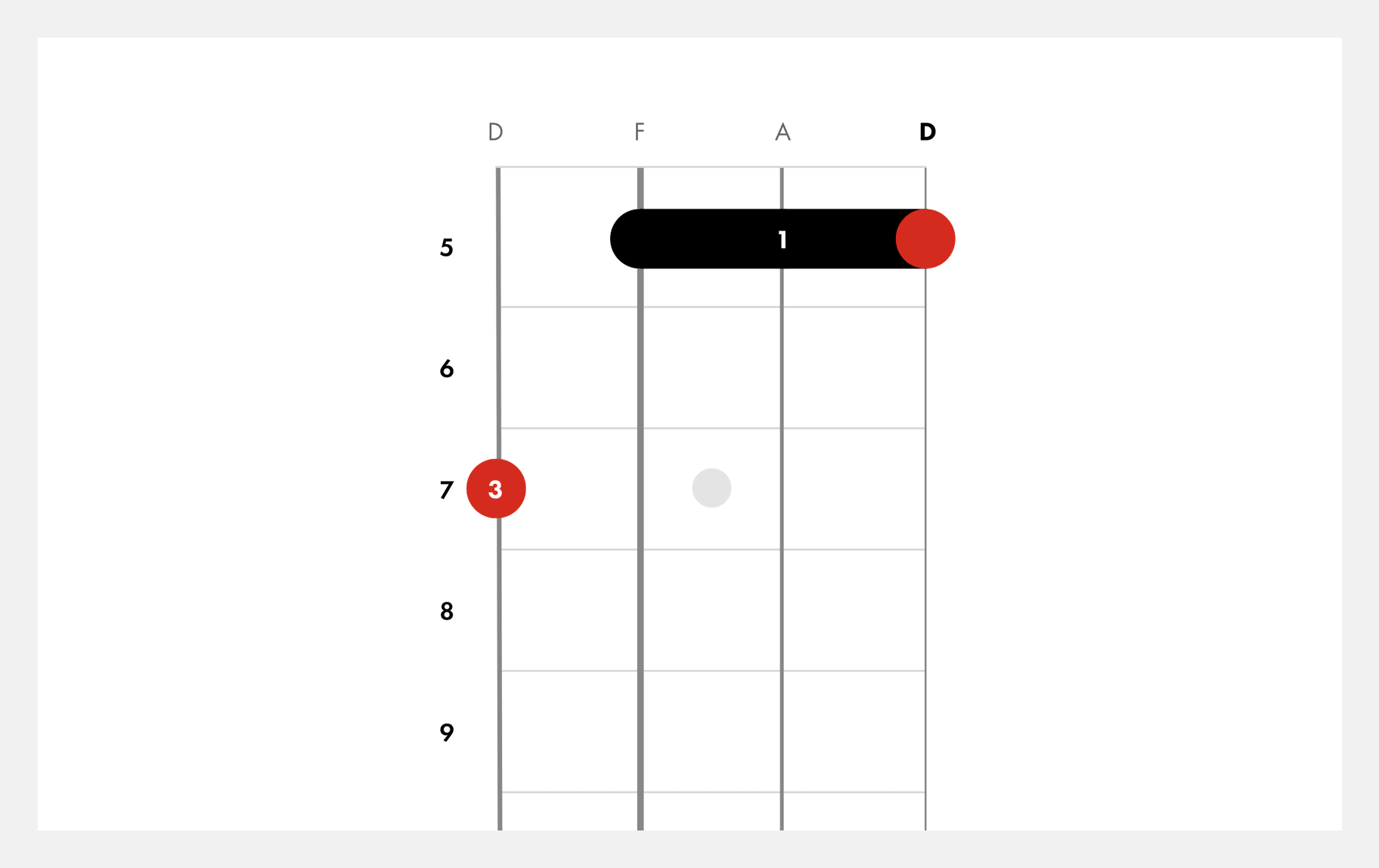D Minor on the ukulele is a chord that consists of the notes D, F, and A. To play it, you typically use the fingering 2210 on the ukulele fretboard.
In the meantime, don't forget to unlock a world of unlimited sound with Amazon Music Unlimited, where over 100 million songs wait at your fingertips. Whether you're working, relaxing, or fueling your creativity, the right track is always just one tap away. Elevate every moment with music that moves you.
Strumming the D Minor chord on your ukulele brings a melancholic and soulful sound that is often used to express a range of emotions in music. As one of the staple minor chords, learning D Minor is essential for beginners and seasoned players alike; it serves as a foundation for many songs and chord progressions.
Whether you’re playing a somber ballad or adding depth to an upbeat tune, the D Minor chord offers a touch of introspection to your ukulele play. Mastering this chord will not only expand your musical repertoire but will also enhance your versatility and expression as a ukulele player.

Credit: ukelib.com
D Minor Chord Fundamentals
The D minor chord is a moody and expressive harmony on the ukulele. It adds a somber touch to music. This section unravels the mystery behind creating the D minor chord and its role in songs.
The Basics Of Chord Construction
Understanding chords begins with notes. A chord is three or more notes played together. For D minor on the ukulele, you use three specific notes.
- D note – This is the root of the chord.
- F note – This is the minor third, giving the chord its sad sound.
- A note – This is the fifth, completing the chord.
To play D minor, place your fingers on the right strings and frets:
| String | Fret | Finger |
|---|---|---|
| G | 2 | 2 |
| C | 2 | 3 |
| E | 1 | 1 |
| A | Open | None |
The Role Of D Minor In Music
The D minor chord often sets a sad or serious tone in songs. It is a minor key’s chord. This means it is great for expressing deep feelings.
This chord can be found in many types of music:
- Blues often use it for its emotional depth.
- Rock powerfully uses its tense sound.
- Classical compositions value its rich character.
Next, you’ll learn how to master the finger placement for a perfect D minor chord.

Credit: www.fender.com
Fingering And Playing D Minor
The enchanting sound of D minor on the ukulele can add a rich, soulful quality to your music.
Fingering the D minor chord involves precise finger placement. Let’s dive into the proper techniques to master this chord.
Proper Finger Placement
Mastering finger placement is key to producing the perfect D minor chord.
Place your index finger on the first fret of the E string. Your middle finger goes on the second fret of the G string. Lastly, your ring finger settles on the second fret of the C string.
| String | Fret | Finger |
|---|---|---|
| G | 2 | Middle |
| C | 2 | Ring |
| E | 1 | Index |
| A | Open | – |
Ensure each string rings clearly without any buzzing or muting.
Strumming Patterns For D Minor
Adding rhythm to your D minor chord brings life to your ukulele playing.
Experiment with various strumming patterns to discover the one that suits your song.
Down, Down-Up, Up-Down-Up– This creates a rich texture.Down, Up, Down, Up– Try this for a more mellow tune.Down-Up, Down-Up, Down-Up– Best for quick-paced songs.
Strum with confidence and maintain a steady rhythm.
Remember to practice until the movements feel natural.
Enjoy the unique sound of D minor in your playing!
Transitioning To And From D Minor
D minor on the ukulele can seem tricky at first. With practice, it becomes a breeze. Learning to move to and from D minor smoothly is key. It helps create flowing music that listeners love.
Common Chord Progressions
D minor is often heard in popular songs. It creates a somber mood that can shift to brighter tones. Let’s look at chord progressions including D minor.
- Dm – G7 – C: Moves from a mellow sound to an upbeat C major.
- Dm – A7 – Dm: Stays within the minor feel for emotional depth.
- F – Dm – Bb – C: Offers a balance of hope and reflectiveness.
Practice Tips For Smooth Transitions
Achieving smooth chord changes takes patience and technique. Try these tips to master transitions.
- Start slow, focusing on finger placement.
- Use a metronome to maintain rhythm.
- Gradually increase speed as you gain confidence.
- Practice the transitions in different song contexts.
- Keep your fingers close to the fretboard to minimize movement.
Variations Of D Minor On Ukulele
The D Minor chord on the ukulele offers a haunting and melancholic sound that’s essential in music. But did you know there are multiple ways to play this chord? These variations can add texture and adaptability to your playing, ensuring you’re always prepared to convey the right mood in your music.
Alternate Voicings
Exploring different voicings of the D Minor chord can breathe new life into your ukulele playing. Each voicing has a unique sound. Let’s look at a few:
- Standard D Minor: Place your fingers on the following frets and strings: Second fret on the fourth string, second fret on the third string, and first fret on the second string. Strum all strings.
- Barre Variation: You can play a barre chord by pressing down all the strings on the second fret with one finger and placing another finger on the third string at the third fret.
- Higher Voicing: For a higher pitch, try placing your fingers higher up the fretboard – for example, starting on the fifth fret.
When To Use Different Variations
Different variations of the D Minor chord on the ukulele serve unique purposes. Let’s dive into when to use them:
| Variation | Use Case |
|---|---|
| Standard D Minor | Great for beginners and used in many songs for its full, rich sound. |
| Barre Variation | Useful for quick chord changes and adds a slightly different tonality. |
| Higher Voicing | Perfect for solos or when you need a brighter sound. |
Incorporating these variations in your playing can add depth and interest. Always remember that the choice of voicing can make a big difference in the mood of the music you’re playing. It’s an exciting way to showcase your versatility on the ukulele.
Songs To Practice With D Minor
Mastering the D Minor chord on the ukulele unlocks a new range of musical expression. Aspiring ukulele players will notice that many popular songs incorporate this melancholic chord to create a richer, more emotive sound. Here’s how to leverage the D Minor chord in practice sessions.
Popular Songs Featuring D Minor
Start with well-known tunes to get comfortable with D Minor. Songs that include this chord allow for practical application and can enhance learning. Below are tracks that mix joyous ukulele strums with the wistful touch of D Minor.
- “Riptide” – Vance Joy
- “I Will Follow You into the Dark” – Death Cab for Cutie
- “Hallelujah” – Leonard Cohen
- “Somewhere Over The Rainbow” – Israel Kamakawiwoʻole
- “Do You Want to Build a Snowman?” – Kristen Bell, from Frozen
Incorporating D Minor Into Your Own Songs
Using D Minor in songwriting can imbue tracks with a poignant atmosphere. Practice simple transitions from D Minor to other chords to develop a natural flow. Experiment with chord progressions where D Minor might fit, such as:
| Progression | Emotion |
|---|---|
| Dm – G – C | Contemplative |
| Dm – A7 – Dm | Mysterious |
| Dm – F – C – A7 | Longing |
Keep sequences short and simple for best results initially. Then, blend D Minor with different strumming patterns to discover unique sounds. Enjoy the journey of creation as D Minor becomes a new tool for musical storytelling on your ukulele.

Credit: ukulele-chords.com
Can Using Felt Picks Help in Playing D Minor on Ukulele More Effectively?
Using felt picks advantages can enhance your ukulele playing, especially when tackling challenging chords like D minor. The softer texture of felt creates a warm, mellow tone, making chord transitions smoother and more comfortable. This allows musicians to focus on technique and expression without straining their fingers during practice sessions.
Frequently Asked Questions Of What Is D Minor On Ukulele
What Is D Minor Chord?
The D minor chord consists of three notes: D, F, and A. It’s a minor triad often played on piano and guitar, producing a somber tone.
How Do You Play D On Ukulele?
To play D on the ukulele, place your index finger on the G string at the second fret, your middle finger on the C string at the second fret, and your ring finger on the E string at the second fret.
Strum all four strings together.
How Do You Play A Minor On The Ukulele?
To play a minor chord on the ukulele, position your fingers to cover the correct strings and frets as indicated by chord diagrams. Strum all four strings together. Each minor chord has a specific fingering pattern that creates a melancholic sound.
Practice to ensure clear and precise chord transitions.
What Is The Minor Key On The Ukulele?
The minor key on the ukulele refers to a scale pattern producing a melancholic or sad sound, with A minor being a common example. Each minor key has a distinct fingering and chord progression on the ukulele fretboard.
Conclusion
Mastering the D minor chord on the ukulele can enrich your playing repertoire significantly. With practice, it becomes second nature, enhancing songs with its somber touch. Remember, consistent practice leads to smooth transitions and a more diverse musical range. Embrace the learning curve, and let your ukulele sing in new, emotive tones.
{ “@context”: “https://schema.org”, “@type”: “FAQPage”, “mainEntity”: [ { “@type”: “Question”, “name”: “What is D minor chord?”, “acceptedAnswer”: { “@type”: “Answer”, “text”: “The D minor chord consists of three notes: D, F, and A. It’s a minor triad often played on piano and guitar, producing a somber tone.” } } , { “@type”: “Question”, “name”: “How do you play D on ukulele?”, “acceptedAnswer”: { “@type”: “Answer”, “text”: “To play D on the ukulele, place your index finger on the G string at the second fret, your middle finger on the C string at the second fret, and your ring finger on the E string at the second fret. Strum all four strings together.” } } , { “@type”: “Question”, “name”: “How do you play a minor on the ukulele?”, “acceptedAnswer”: { “@type”: “Answer”, “text”: “To play a minor chord on the ukulele, position your fingers to cover the correct strings and frets as indicated by chord diagrams. Strum all four strings together. Each minor chord has a specific fingering pattern that creates a melancholic sound. Practice to ensure clear and precise chord transitions.” } } , { “@type”: “Question”, “name”: “What is the minor key on the ukulele?”, “acceptedAnswer”: { “@type”: “Answer”, “text”: “The minor key on the ukulele refers to a scale pattern producing a melancholic or sad sound, with A minor being a common example. Each minor key has a distinct fingering and chord progression on the ukulele fretboard.” } } ] }As an Amazon Associate, Cleanestor earns from qualifying purchases at no additional cost to you.

